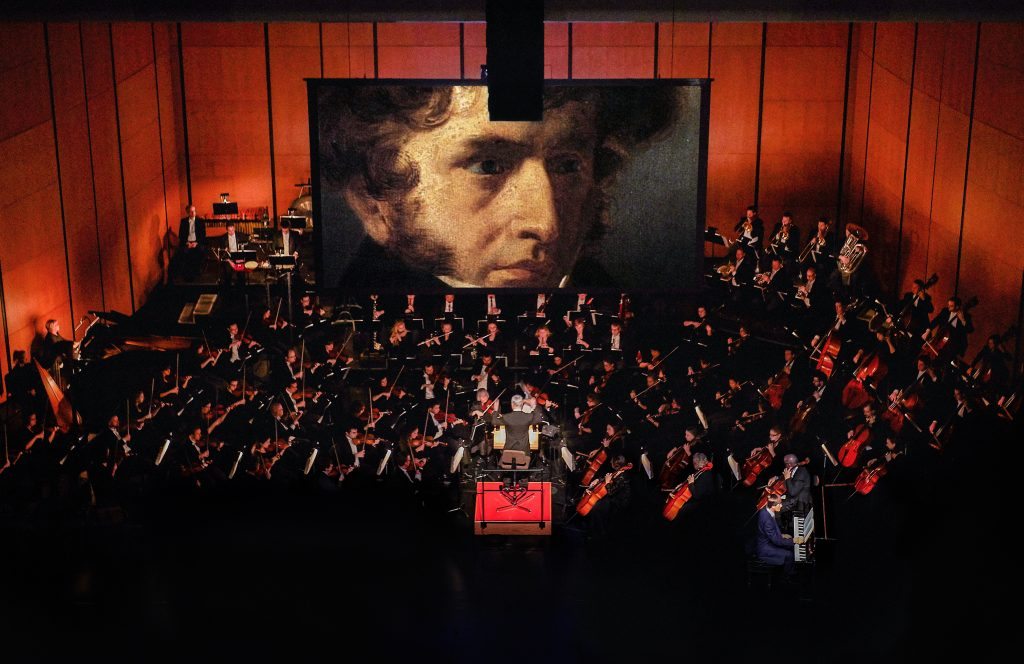Leonard Bernstein famously said of the Berlioz Symphonie fantastique, Op 14 (1830), “You can become a nervous wreck playing this symphony; but then, that’s what it is: a portrait of a nervous wreck.” The performance of this programmatic work is an excellent opportunity to tell the story, of French composer Hector Berlioz falling in love with an Irish actress named Harriet Smithson and attempting to get her attention by writing a symphony for her, behind its inception with a project like “Beyond the Score.” The Des Moines Symphony performed this program admirably with attention to detail and a commitment to audience development.
The Des Moines Symphony is not known for its robust audience development programs. However, this “Beyond the Score” production, developed and pioneered by Chicago Symphony Orchestra, is helping to change that around. “Beyond the Score” is a multimedia production meant to enhance the audience’s understanding of the symphonic work through artistic visual projections, an actor playing the composer Berlioz, a dancer portraying his love interest, and a tour through the musical themes and arrival points in the score. This is the classical music world’s version of VH1’s Pop Up Video and Behind The Music. In my experience with this symphony and this audience, it is quite effective. There was a palpable sense of connection to the music throughout the full performance of Symphonie fantastique later in the program. In the “Beyond the Score” performance the actor playing Berlioz discuss concepts namely the “idée fixe” with evocative language such as, “there was a woman, a perfect vision, that I could only view when hearing a certain musical phrase” which very succinctly gives context to the melody that returns again and again. And, the audience heard it. There were moments of noticeable connection to elements that had been discussed in the earlier part of the program. “Beyond the Score” is a shining example of initiatives that help audiences feel more informed without being made to feel unintelligent. It is a fine line to walk. This production happens to be a very thoughtful approach to holistic audience education that serves the Des Moines Symphony well.
One of the hidden benefits of the “Beyond the Score” program is that the ensemble is able to rehearse this one work and devote more time and attention to its nuance and musicality. It was a pleasure to see Maestro Joseph Giunta conduct without the score which seemed to afford him not only the opportunity for more slightly amusing gestures but more tranquil phrasing of the musical line. This attention to detail was most discernible during the hand-off of melodic phrases from one instrument or soli section to another including the third movement when the first violins practically blossomed out of the conclusion of one of the english horn solos. Another highlight of the evening was the opening of the fifth and final movement “Dream of a Witches’ Sabbath: Larghetto – Allegro.” The effect of the pitch bends in the piccolo, flute, and oboe, mixed with the bass drum rolls, and heightened with the cello and bass symmetric scales was deliciously ominous and set up the rest of the movement to be suitably terrifying.

The Des Moines Symphony also took the opportunity to announce their 80th season during this weekend’s performances. There are many more opportunities to hear important symphonic works next season as well as a few gems like the Iowa debut of Manuel de Falla’s 1914-1915 composition “El amor brujo,” which features Venezuelan dancer Siudy Garrido and her dance company as well as an Augusta Read Thomas 2018 world premiere. For more information on the 2017-2018 80th Season lineup, visit the Des Moines Symphony website dmsymphony.org.
